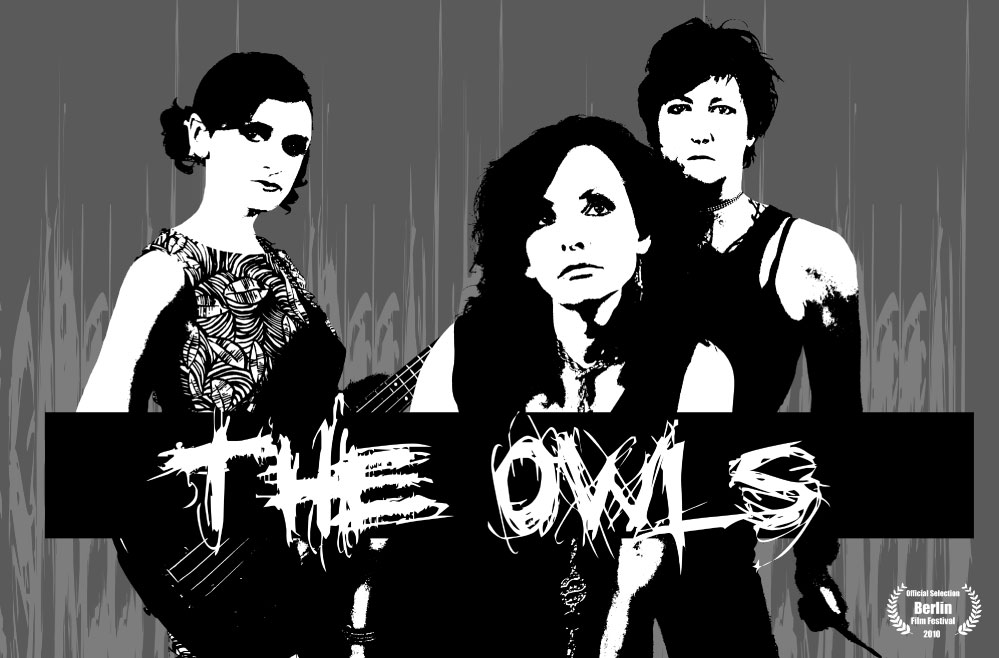|
The Paliament Film Collective's (Partial) Canon of Lesbian Cinema |
||||
 |
||||
Poster for The Owls (dir. Cheryl Dunye, 2010). Used with permission from the Parliament Film Collective. |
||||
A Lesbian Collective Aesthetic:
Making and Teaching The Owls
By Alexandra Juhasz
With videos and voices of Love Ablan, V.S. Brodie, Campbell, Agusta Einsardottir, Cheryl Dunye, Candi Guterres, Tania Hammidi, Allison Kelly, Michael Lucid, and Sarah Schulman
(Double-click each name for a pop-up biography)
Introduction
This essay is about making, teaching, and learning from lesbian cinema in two completely interrelated ways. On the one hand, I will focus on making (and then teaching) The Owls (Cheryl Dunye, 2010), “a generational anthem for Older Wiser Lesbians [OWLs], aging revolutionaries in a world they cannot control. A funny, humane look at the bonds that restrain and the dreams that remain.”1 The Owls is a production of the Parliament Film Collective, which I formed along with Dunye and fellow producers Candi Guterres and Ernesto Foronda as a way of acting on our frustration with the limitations of both corporate and contemporary (mainstream) queer filmmaking. We invited others to join us, and the sixty or so of us—lesbian and queer, multiracial and with a range of professional experience—worked together to create the film. Beginning with a script written by Dunye and lesbian novelist and playwright Sarah Schulman, the cast and crew drew on their own experiences to add to the understandings, interpretations, and script of the film (not to mention its unscripted documentary elements; most of the cast and crew were interviewed about the film’s ideas and processes, and some of these interviews were included in the film), thus reflecting the importance of collective process for the OWLs generation and our film about it. On the other hand, I will discuss how this conversational, open-ended, film-based making and teaching is our “lesbian collective aesthetic.” Which is to say that, while most understandings of cinema aesthetics look primarily to film form and content (style and story), here I will suggest that the extra-textual feminist processes of collectively making (by first discussing and leaving room for multiple interpretations) lesbian cinema and identity and then critically and communally teaching (and then conversing again) about the practices of making cinema (and identity) are of greatest importance for me as an activist scholar, an educator, and a filmmaker, as well as for the collective I participated in: one committed to radical, inclusive, collaborative lesbian filmmaking.
For reasons both political and precise to our practices, I will argue that our film’s lesbian aesthetic is a product of its collective methods and its inventive forms, which are both inseparable from its lesbian story, politics, and ideals (even as many queers were part of this “lesbian” collective process). The same holds true for the lesbian collective aesthetic of this essay. As we did to make the film, I will play inventively here with queer collective expressivity. I have composed this essay (and its Partial Canon) using the collective writings and videotaped words of eleven volunteers from the Parliament Film Collective. In this way, the form and method of the article attempt to mirror the collective engagement and processes of the film it discusses. And in this way, the piece introduces, through its form, one of its main arguments about lesbian cinema aesthetics: method and form matter, and then education (or teaching) must as well, because the making of cinema is typically obscured from its text and the text’s reception. In relation to lesbian collective cinema, teaching can be particularly powerful in its own right if this pedagogy can keep its focus on process as much as story, or, harder still, on process as story.
I worked on The Owls as one producer among many (including Agusta Einarsdottir, Cheryl Dunye, Ernesto Foronda, Candi Guterres, Skip Snow, and Molly Sturdevant), all of us doing our part in a collective crew working for free in the name, spirit, and celebration of low-budget, collaborative, experimental lesbian cinema. The film is a feature-length documentary/fiction hybrid about four Older Wiser Lesbians who accidentally kill a young lesbian and try to get away with it. Our lesbian film does a rare thing within this tradition: representing post–baby-dyke lesbian life with no sugar coating. It watches four women in two long-term relationships trying to make sense of the weight of alcoholism, infidelity, infertility, aging, and murder. The Owls also gracefully (if sometimes gruesomely) mixes the stories of its thriller characters with those of its behind-the-scene makers, creating space first within its production processes and then within the film itself for the difficult and often glossed over debates and conversations that underlie contemporary lesbian identity, culture, and cinema: the friction created within cross-generational interactions and relations between butches and trans men, around politics of identity and visibility, and amongst the competing practices and histories of lesbian/queer cinema.
Copyright © 2014. All rights reserved.